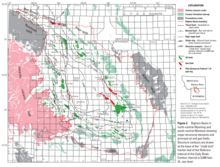Bighorn Basin


The Bighorn Basin is a plateau region and intermontane basin, approximately 100 miles (160 km) wide, in north-central Wyoming in the United States. It is bounded by the Absaroka Range on the west, the Pryor Mountains on the north, the Bighorn Mountains on the east, and the Owl Creek Mountains and Bridger Mountains on the south. It is drained to the north by tributaries of the Bighorn River, which enters the basin from the south, through a gap between the Owl Creek and Bridger Mountains, as the Wind River, and becomes the Bighorn as it enters the basin. The region is semi-arid,[1] receiving only 6–10 in (15–25 cm) of rain annually.
The largest cities in the basin include the Wyoming towns of Cody, Thermopolis, Worland, and Powell. Sugar beets, pinto beans, sunflowers, barley, oats, corn and alfalfa hay are grown on irrigated farms in the region.
History
The basin was explored by
In 1942 one of the nation's ten
Geology



The Bighorn Basin forms a geologic
Some uranium has been mined in the northern part of the basin, along the Bighorn Mountains.
The eastern section of the basin is famously rich in
The alluvial strata of the
Communities
Notable Features
See also
- Uranium mining in Wyoming
- Wind River Basin
- Wyoming Basin shrub steppe
- Bighorn Basin Dinosaur Project
References
- .
- ^ John P. Weldon (1972) The Big Horn Basin in Geologic Atlas of the Rocky Mountain Region, Denver: Rocky Mountain Association of Geologists, p.270-272.
- doi:10.1130/B26104.1.
- .
- ISBN 978-0-8137-2369-3.
- PMID 18268338.
